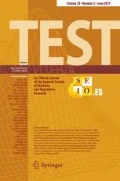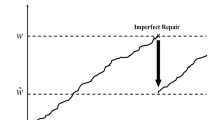Abstract
We develop new models for imperfect repair and the corresponding generalized renewal processes for stochastic description of repairable items that fail when their degradation reaches the specified deterministic or random threshold. The discussion is based on the recently suggested notion of a random virtual age and is applied to monotone processes of degradation with independent increments. Imperfect repair reduces degradation of an item on failure to some intermediate level. However, for the nonhomogeneous processes, the corresponding age reduction, which sets back the ‘clock’ of the process, is also performed. Some relevant stochastic comparisons are obtained. It is shown that the cycles of the corresponding generalized imperfect renewal process are stochastically decreasing/increasing depending on the monotonicity properties of the failure rate that describes the random failure threshold of an item.
Similar content being viewed by others
References
Badia FG, Berrade MD. (2009). Optimum maintenance policy of a periodically inspected system under imperfect repair. Adv Oper Res. Article ID 691203
Badıa FG, Berrade MD, Campos CA (2002) Optimal inspection and preventive maintenance of units with revealed and unrevealed failures. Reliab Eng Syst Saf 78:157–163
Barlow RE, Proschan F (1975) Statistical theory of reliability and life testing. Holt, New York
Belzunce F, Riquelme CM, Mulero J (2015) An Introduction to stochastic orders. Academic Press, Cambridge
Berenguer C, Grall A, Dieulle L (2003) Maintenance policy for a continuously monitored deteriorating system. Probab Eng Inf Sci 17:235–250
Castro IT (2013) An age-based maintenance strategy for a degradation-threshold shock-model for a system subjected to multiple defects. Asia Pac J Oper Res 30:1350016–1350029
Castro IT, Mercier S (2016) Performance measures for a deteriorating system subject to imperfect maintenance and delayed repairs. J Risk Reliab 230:364–377
Cha JH, Finkelstein M. (2018). Point Processes for Reliability Analysis. Shocks and Repairable systems. London, Springer.
Dijoux Y, Fouladirad M, Nguyen DT (2016) Statistical inference for imperfect maintenance models with missing data. Reliab Eng Syst Saf 154:84–96
Doyen L, Gaudoin O (2004) Classes of imperfect repair models based on reduction of failure intensity or virtual age. Reliab Eng Syst Saf 84:45–56
Etminan J, Kamranfar H, Chahkandi M, Fouladirad M (2022) Analysis of time-to-failure data for a repairable system subject to degradation. J Comput Appl Math. https://doi.org/10.1016/j.cam.2022.114098
Finkelstein M (2007) On some ageing properties of general repair processes. J Appl Probab 44:506–513
Finkelstein M (2008) Failure rate modelling for reliability and risk. Springer, London
Finkelstein M, Cha JH (2013) Stochastic modelling for reliability (shocks, burn-in and heterogeneous populations). Springer, London
Finkelstein M, Cha JH (2021) On degradation-based imperfect repair and induced generalized renewal processes. TEST. https://doi.org/10.1007/s11749-021-00765-z
Kahle W (2019) Imperfect repair in degradation processes: a Kijima-type approach. Appl Stoch Model Bus Ind 35:211–220
Kamranfar H, Fouladirad M, Balakrishnan N (2021) Inference for a gradually deteriorating system with imperfect maintenance. Commun Stat-Simul Comput. https://doi.org/10.1080/03610918.2021.2001528
Kijima M (1989) Some results for repairable systems with general repair. J Appl Probab 26:89–102
Krivtsov VV (2007) Recent advances in theory and applications of stochastic point process models in reliability engineering. Reliab Eng Syst Saf 92:549–551
Levitin G, Lisniansky A (2000) Optimization of imperfect preventive maintenance for multi-state systems. Reliab Eng Syst Saf 67:193–203
Meeker WQ, Escobar LA (2014) Statistical methods for reliability data. Wiley, Hoboken
Mercier S, Castro IT (2019) Stochastic comparisons of imperfect maintenance models for a gamma deteriorating system. Eur J Oper Res 273:237–248
Müller A, Stoyan D (2002) Comparison methods for stochastic models and risks. Wiley, Chichester
Nguyen DT, Dijoux Y, Fouladirad M (2017) Analytical properties of an imperfect repair model and application in preventive maintenance scheduling. Eur J Oper Res 256:439–453
Ponchet A, Fouladirad M, Grall A (2011) Maintenance policy on a finite time span for a gradually deteriorating system with imperfect improvements. J Risk Reliab 225:105–116
Sadeghi J, Najar M, Mollazadeh M, Yousefi B, Zakeri J (2018) Improvement of railway ballast maintenance approach, incorporating ballast geometry and fouling conditions. J Appl Geophys 151:263–273
Salles G, Mercier S, Bordes L (2020) Semiparametric estimate of the efficiency of imperfect maintenance actions for a gamma deteriorating system. J Stat Plan Inference 206:278–297
Shaked M, Shanthikumar J (2007) Stochastic orders. Springer, New York
Tanwar M, Rai RN, Bolia N (2014) Imperfect repair modeling using Kijima type generalized renewal process. Reliab Eng Syst Saf 124:24–31
van Noortwijk JM (2009) A survey of the application of gamma processes in maintenance. Reliab Eng Syst Saf 94:2–21
Wang H, Pham H (2006) Reliability and optimal maintenance. Springer, London
Zhao X, Gaudoin O, Doyen L, Xie M (2019) Optimal inspection and replacement policy based on experimental degradation data with covariates. IISE Trans 5:322–336
Acknowledgements
The authors thank the reviewers for helpful comments and advices. The work of the second author was supported by Basic Science Research Program through the National Research Foundation of Korea (NRF) funded by the Ministry of Education (Grant Number: 2019R1A6A1A11051177).
Author information
Authors and Affiliations
Corresponding author
Additional information
Publisher's Note
Springer Nature remains neutral with regard to jurisdictional claims in published maps and institutional affiliations.
Appendix
Appendix
We first need some definitions and preliminary lemmas on multivariate stochastic orders.
Definition A1
Let \({\mathbf{X}}{ = (}X_{1} ,X_{2} ,\ldots,X_{n} )\) and \({\mathbf{Y}}{ = (}Y_{1} ,Y_{2} ,\ldots,Y_{n} )\) be two \(n\)-dimensional random vectors such that
Then, \({\mathbf{X}}\) is said to be smaller than \({\mathbf{Y}}\) in the usual stochastic order, denoted by \({\mathbf{X}} \le_{st} {\mathbf{Y}}\).
Lemma A1
(Shaked and Shanthikumar 2007) Let \({\mathbf{X}}{ = (}X_{1} ,X_{2} ,\ldots,X_{n} )\) and \({\mathbf{Y}}{ = (}Y_{1} ,Y_{2} ,\ldots,Y_{n} )\) be two \(n\)-dimensional random vectors. If
and, for \(i = 2,3,\ldots,n\)
\((X_{i} |X_{1} = x_{1} ,X_{2} = x_{2} ,\ldots,X_{i - 1} = x_{i - 1} ) \le_{st} (Y_{i} |Y_{1} = y_{1} ,Y_{2} = y_{2} ,\ldots,Y_{i - 1} = y_{i - 1} )\) whenever \(x_{j} \le y_{j}\), \(j = 1,2,\ldots,i - 1\), then \({\mathbf{X}} \le_{st} {\mathbf{Y}}\).
Lemma A2
(Shaked and Shanthikumar 2007) Let \({\mathbf{X}}{ = (}X_{1} ,X_{2} ,\ldots,X_{n} )\) and \({\mathbf{Y}}{ = (}Y_{1} ,Y_{2} ,\ldots,Y_{n} )\) be two \(n\) -dimensional random vectors. If \({\mathbf{X}} \le_{st} {\mathbf{Y}}\) and \({\mathbf{g}}\) : \({\mathbf{R}}^{n} \to {\mathbf{R}}^{k}\) is any \(k\)-dimensional increasing (decreasing) function, for any integer \(k\), then the \(k\)-dimensional vectors \({\mathbf{g}}({\mathbf{X}})\) and \({\mathbf{g}}({\mathbf{Y}})\) satisfy \({\mathbf{g}}({\mathbf{X}}) \le_{st} ( \ge_{st} ){\mathbf{g}}({\mathbf{Y}})\) .
Theorem A1
Suppose that the distribution \(G(x)\) is DFR, i.e., \(\lambda_{L} (x)\) is decreasing in \(x\) . Then,
Proof
First, we show \(L_{1} <_{st} L_{2}\). Observe that
whereas
and \(P(L_{2} > w) = E[P(L_{2} > w|L_{1} )]\). When \(\lambda_{L} (x)\) is decreasing,
This implies that \(P(L_{1} > w) \le E[P(L_{2} > w|L_{1} )] = P(L_{2} > w)\), for all \(w > 0\).
Observe that
Thus, \(P(L_{3} > w|L_{1} = w_{1} ,L_{2} ) =\exp \left\{ - \int\limits_{0}^{w} {\lambda_{L} (q^{2} w_{1} + qL_{2} + x){\rm d}x}\right\} \ge\exp \left\{ - \int\limits_{0}^{w} {\lambda_{L} (qL_{2} + x){\rm d}x }\right\}\), and
On the other hand, \(P(L_{2} > w) = E\left[\exp \left\{ - \int\limits_{0}^{w} {\lambda_{L} (qL_{1} + x){\rm d}x }\right\} \right]\). As \(L_{1} \le_{st} (L_{2} |L_{1} = w_{1} )\), for all realization of \(w_{1} > 0\), due to Lemma 1-(i),(ii),
\(\ge E\left[\exp \left\{ - \int\limits_{0}^{w} {\lambda_{L} (qL_{1} + x){\rm d}x}\right\} \right] = P(L_{2} > w)\), for all realization of \(w_{1} > 0\), for all \(w > 0\),
which implies that \(P(L_{3} > w) \ge P(L_{2} > w)\), for all \(w > 0\).
In general, for \(n = 3,4,\ldots\),
and
Thus,
and
Now we stochastically compare \((L_{1} ,L_{2} ,\ldots,L_{n - 1} )\) with \((L_{2} ,L_{3} ,\ldots,L_{n} |L_{1} = w_{1} )\). From (A1),
Also,
whereas
where \(V_{j} = L_{j + 1}\), \(j = 1,2,\ldots\). Then, we have
for all \(w > 0\), whenever \(w_{j} \le v_{j}\), \(j = 1,2,\ldots,i - 1\), which implies that
whenever \(w_{j} \le v_{j}\), \(j = 1,2,\ldots,i - 1\). Inequality (A2) holds for all \(i = 2,\ldots,n - 1\). Thus, by Lemma A1, \((L_{1} ,L_{2} ,\ldots,L_{n - 1} ) \le_{st} (V_{1} ,V_{2} ,\ldots,V_{n - 1} |L_{1} = w_{1} )\) and thus
Observe that
is an increasing function of \((w_{1} ,w_{2} ,\ldots,w_{n - 1} )\). Then, from (A3) and Lemma A3,
for all realization of \(w_{1} > 0\), for all \(w > 0\). This again implies that
Therefore, we have shown that \(P(L_{n} > w) \le P(L_{n + 1} > w)\), for all \(n = 1,2,\ldots\)
■
Theorem A2
Suppose that the distribution \(G(x)\) is DFR, i.e., \(\lambda_{L} (x)\) is decreasing in \(x\) . Then,
Proof
It is obvious that \(Z_{1} \le_{st} Z_{2}\). In the proof of Theorem A1, we have shown that
Furthermore,
is an increasing function of \((w_{1} ,w_{2} ,\ldots,w_{n - 1} )\). Then, from Lemma A2,
which implies that \(Z_{n} \le_{st} (Z_{n + 1} |L_{1} = w_{1} )\), for all realizations of \(w_{1}\). Therefore, we have
■
Rights and permissions
About this article
Cite this article
Finkelstein, M., Cha, J.H. Reducing degradation and age of items in imperfect repair modeling. TEST 31, 1058–1081 (2022). https://doi.org/10.1007/s11749-022-00813-2
Received:
Accepted:
Published:
Issue Date:
DOI: https://doi.org/10.1007/s11749-022-00813-2




